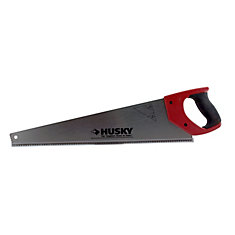Sawing straight is one of the more important skill in your workshop. When your cut is not straight you will need a lot more planing and you may have to scrap a piece once in a while.
You do have a few choices, let's explore them.
- Big box hardware store saw

Their main advantage is that you don't need to learn sharpening. From my point of view, knowing sharpening, I have to say that I don't own one of those and don't want to see that kind of saw with plastic handles in my shop.
I really have a hard time to see those saws side-by-side with a nice Lie-Nielsen plane or even an old Stanley.
- Brand new saw sold by Lie-Nielsen or LeeValley.

I'm sure that this saw works great but it's being sold for 289$Can right now by LeeValley. Lie-Nielsen do have similar saws for the same kind of price.
If you do have the budget to buy one of these, you will also need to learn how to sharpen. I believe that it's more difficult to learn to sharpen a saw than a plane blade but, do you really want to learn sharpening with this beautiful saw?
- Old Disston or Warrented Superior

Those saws can be found on the resale market for a few dollars. They usually come in very bad condition (rusty, not sharpen, broken teeth) and rip saws are fairly difficult to find. I own two rip saws and for each one I had to remove all the teeth (they were crosscut) and recut them.
Just like the expensive LV or LN saw you need to learn sharpening but it's the perfect tool to learn this skill.
So far, I've restored approximately twenty of those saws and they all had (except one) their teeth on an arc which require a lot of jointing and filing.
If you want to learn how to sharpen I do have a blog on this here (more on this topic to be translated from the french side of this blog shortly).
In my shop this is the kind of saws that I use. I like their look, they are inexpensive and they are not of the throw away style.
- Japanese saws Ryobi style.

Looking at videos on the web, it's obvious that some users are getting very good results with that kind of saw...but not me! I just can't saw straight with those.
They are not very expensive and you don't need to know sharpening. This is a pretty good combination for a beginner as long as you can master their use and cut straight.
Another advantage of those saws is that you need only one. They have two different teeth pattern, one for crosscutting and one for ripcutting.
I have no problem to use a Dozuki style that has a rigid back.

As you can see it's not really obvious to choose. You really have to decide if you want to learn sharpening or not.
No comments:
Post a Comment